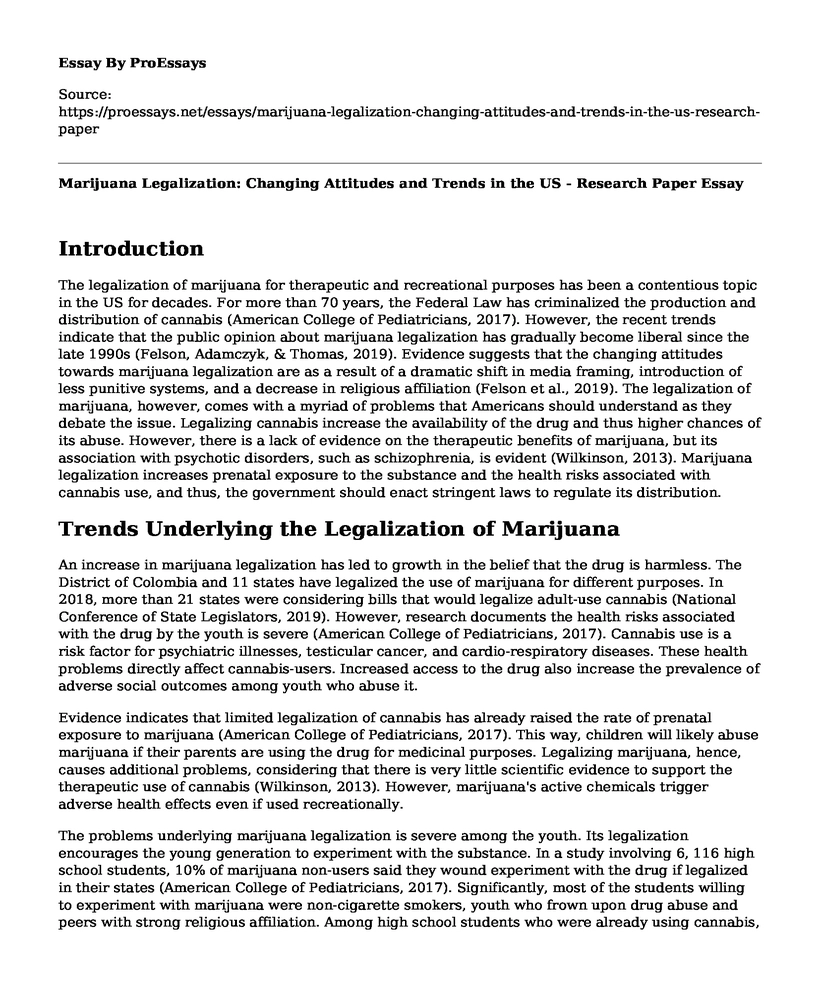Introduction
The legalization of marijuana for therapeutic and recreational purposes has been a contentious topic in the US for decades. For more than 70 years, the Federal Law has criminalized the production and distribution of cannabis (American College of Pediatricians, 2017). However, the recent trends indicate that the public opinion about marijuana legalization has gradually become liberal since the late 1990s (Felson, Adamczyk, & Thomas, 2019). Evidence suggests that the changing attitudes towards marijuana legalization are as a result of a dramatic shift in media framing, introduction of less punitive systems, and a decrease in religious affiliation (Felson et al., 2019). The legalization of marijuana, however, comes with a myriad of problems that Americans should understand as they debate the issue. Legalizing cannabis increase the availability of the drug and thus higher chances of its abuse. However, there is a lack of evidence on the therapeutic benefits of marijuana, but its association with psychotic disorders, such as schizophrenia, is evident (Wilkinson, 2013). Marijuana legalization increases prenatal exposure to the substance and the health risks associated with cannabis use, and thus, the government should enact stringent laws to regulate its distribution.
Trends Underlying the Legalization of Marijuana
An increase in marijuana legalization has led to growth in the belief that the drug is harmless. The District of Colombia and 11 states have legalized the use of marijuana for different purposes. In 2018, more than 21 states were considering bills that would legalize adult-use cannabis (National Conference of State Legislators, 2019). However, research documents the health risks associated with the drug by the youth is severe (American College of Pediatricians, 2017). Cannabis use is a risk factor for psychiatric illnesses, testicular cancer, and cardio-respiratory diseases. These health problems directly affect cannabis-users. Increased access to the drug also increase the prevalence of adverse social outcomes among youth who abuse it.
Evidence indicates that limited legalization of cannabis has already raised the rate of prenatal exposure to marijuana (American College of Pediatricians, 2017). This way, children will likely abuse marijuana if their parents are using the drug for medicinal purposes. Legalizing marijuana, hence, causes additional problems, considering that there is very little scientific evidence to support the therapeutic use of cannabis (Wilkinson, 2013). However, marijuana's active chemicals trigger adverse health effects even if used recreationally.
The problems underlying marijuana legalization is severe among the youth. Its legalization encourages the young generation to experiment with the substance. In a study involving 6, 116 high school students, 10% of marijuana non-users said they wound experiment with the drug if legalized in their states (American College of Pediatricians, 2017). Significantly, most of the students willing to experiment with marijuana were non-cigarette smokers, youth who frown upon drug abuse and peers with strong religious affiliation. Among high school students who were already using cannabis, 18% opined that they would use more marijuana if its consumption is decriminalized (American College of Pediatricians, 2017). Another study in Colorado indicates that about 74% of children under drug abuse treatment had used other people's therapeutic and recreational marijuana (American College of Pediatricians, 2017).
Conclusion
The legalization of marijuana has a direct correlation with unintended exposure to the youth. This way, children tend to abuse cannabis prescribed for therapeutic and recreational purposes. This situation has increased the prevalence of adverse social effects of marijuana. Also, its legalization has increased the risk factors of health conditions associated with bhang use. These problems directly affect people that consistently use marijuana for medicinal and recreational purposes. Legalization of marijuana makes youth believe that the drug is harmless, and thus, one of the factors that contribute to the problem.
References
American College of Pediatricians. (2017, April). Marijuana use: Detrimental to Youth. Retrieved October 18, 2019, from https://www.acpeds.org/the-college-speaks/position-statements/effect-of-marijuana-legalization-on-risky-behavior/marijuana-use-detrimental-to-youth/url/
Felson, J., Adamczyk, A., & Thomas, C. (2019). How and why have attitudes about cannabis legalization changed so much? Social Science Research, 78, 12-27. DOI: 10.1016/j.ssresearch.2018.12.011
National Conference of State Legislators. (2019, July 26). Overview of marijuana legalization. Retrieved October 18, 2019, from http://www.ncsl.org/research/civil-and-criminal-justice/marijuana-overview.aspx/url/
Wilkinson, S. T. (2013). More Reasons States Should Not Legalize Marijuana: Medical and Recreational Marijuana: Commentary and Review of the Literature. Missouri medicine, 110(6), 524. Retrieved October 18, 2019, from https://www.ncbi.nlm.nih.gov/pmc/articles/PMC6179811/url/
Cite this page
Marijuana Legalization: Changing Attitudes and Trends in the US - Research Paper. (2023, Feb 27). Retrieved from https://proessays.net/essays/marijuana-legalization-changing-attitudes-and-trends-in-the-us-research-paper
If you are the original author of this essay and no longer wish to have it published on the ProEssays website, please click below to request its removal:
- Witness Interview, Statement and Interview Analysis Paper Example
- Research Paper on Death Sentence
- Paper Example on Problem-Solving Courts
- Laura Murder Case Paper Example
- US Terrorism and Homeland Security: I Am Malala
- The Misunderstood Right: Understanding Freedom of Speech - Essay Sample
- Cybercrime: Autonomy, Automation & Physical Agency - Essay Sample







